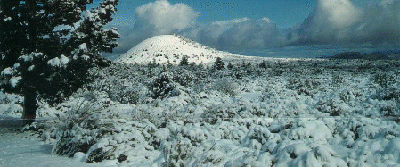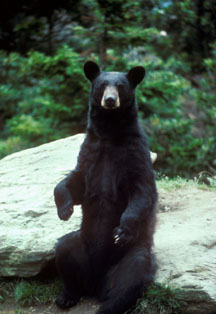Modoc Bioregion

Sometimes referred to as "sagebrush steppe" country, the high and dry Modoc region ecologically belongs more to the Great Basin desert bioregions to the east than to California’s other zones.
Vegetation
Juniper and sagebrush cover much of the eastern, desert side of the Modoc bioregion.
Lava Beds National Monument
Yellow and Jeffrey pine, white fir, mixed conifer, cedar, and aspen are common in the mountainous and forested areas of the west.
Rare plants: Yellow arrowleaf, balsam root, long-haired star tulip, spiny milkwort, Ash Creek ivesia, Raven’s lomatium, and woolly stenotus.
Climate
Hot, dry summers and cold, damp winters with snow at higher elevations are the norm in the Modoc bioregion.
Major natural features and areas
The geography of this sparsely populated bioregion is varied. To the west lie forests, mountains, volcanic lava fields and barrens and wetlands. To the east lies high desert, which borders Nevada. Lassen Volcanic National Park is dotted with lakes and crowned by 10,457-foot Lassen Peak. The region is bordered by Tule Lake and Clear Lake National Wildlife Refuges, Ahjumawi Lava Springs State Park and Lava Beds National Monument on the western side and desert alkali lakes, Honey Lake Valley and Modoc National Wildlife Refuge to the east.
The Modoc bioregion includes the Modoc and parts of Lassen and Klamath National Forests. Its largest lakes are Lake Almanor, Eagle Lake, Lower Klamath Lake, and Goose Lake. The Pit River flows southwest from the rugged Warner Mountains across the Modoc Plateau and into the Sacramento River.

Wildlife
Among the wildlife of the Modoc region are ospreys, Canada geese, black-crowned night herons, cinnamon teal, northern pintails, sage grouse, hummingbirds, great horned owls, goshawk, mule deer, muskrats, marmots, black bears, coyotes, porcupine, pronghorn antelope and rainbow trout.Threatened and endangered species: bald eagles, greater sandhill cranes, Swainson’s hawks, bank swallow, Lost River sucker, Modoc sucker and Shasta crayfish.
Threats
Industrial logging– Logging, including in the bioregion’s national forests, poses all-too-familiar threats to the area’s wildlife and waterbodies. Some logging also takes place on the publicly owned LaTour State Forest.
Overgrazing– Overgrazing is one of the major environmental issues in this bioregion, where ranching is widespread. Cattle denude soil, hasten erosion, pollute creeks, and trample sagebrush, reducing food and shelter for many species.
For more information on environmental threats in the Modoc bioregion, visit: Shasta Group Sierra Club http://motherlode.sierraclub.org/shasta/index.html
Butte Environmental Council http://www.becnet.org/
©2025 Forests Forever. All Rights Reserved.